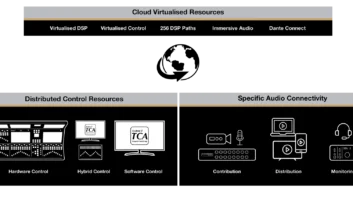Forbidden Technologies has seen impressive growth with broadcast post sales of its cloud video platform increasing by 94% in the first half of 2011. Melanie Dayasena-Lowe met with CEO Stephen Streater to find out what has driven the company’s rapid success rate.
The path to success for Forbidden Technologies has been a rocky one but the company’s determination has seen it through. Before Forbidden Technologies, CEO Stephen Streater started off in the business world with an invention for moving video editing off tape and onto computers. With the help of a venture capitalist, Streater decided to develop his idea into a business and set up a company called Eidos.
The venture capitalist invested £20,000 in the company but as Streater was a PhD student his initial share capital was just £4. Within a year, the company had raised £1 million on the stock market. The company grew its customer base with the likes of the BBC and ITV signing up.
Eidos made editing software for broadcast, and Streater explains why this system stood out against the competitors: “The unusual thing was that the editing was done entirely in software. All the other editing systems like Avid needed hardware, such as JPEG cards, to do the video because computers weren’t fast enough to handle video directly.
“We ran our software on Acorn machines, which used the ARM chip. ARM now outsells Intel in number of units shipped each year. We were lucky to have such early access to that design. The problem was that Acorn stopped making computers so we couldn’t base our business on their platform any more.”
During the 1999-2000 internet explosion, he decided to set up a company to move everything to the web. “We had a big advantage over all the other professional products around in that my compression, and the handling of the video, all ran in software. Java was just coming out, allowing people to run software on the web – including, in principle, video playback software. So we could now make a video editing system run entirely on the web. None of our professional competitors were equipped to do that because they relied on hardware and you couldn’t run the hardware on the web.”
Forbidden is born
Streater went on to found Forbidden Technologies, which started off working on video playback for web browsers, with no installation or configuration required. When, in 2001, Forbidden launched its first video player, there was nothing like it on the market.
“That was partly the problem – no-one had video on their web pages. So we couldn’t go to companies and say ‘this is how to do your video’. They all used Flash – which didn’t support video,” explains Streater. A stumbling block was the sophisticated nature of making a video as you needed people to film, edit and script it but the web designers didn’t know how to make videos.
Next, Forbidden approached mobile phone companies with the idea of playing full screen, full motion video on mobile phones without needing 3G. However, the mobile operators had just heavily invested in 3G: “The ones who did talk to us had just spent billions of pounds on 3G licences and the only thing they could think of that needed 3G was video. So doing full screen, full motion video on 2.5G might have forced them to write down their 3G investment. They weren’t too keen on our 2.5G solution, so we didn’t have much luck there!”
In 2003 the company launched live video over the web – again without the need for any installation to play it back. “We put a live video demo on our website and we were getting 1 million hits a month.” Forbidden presented this solution to broadcasters at IBC in 2003.
“They thought it was amazing but they didn’t have the internet rights to the video, or the non-UK rights if they were a UK broadcaster, so they couldn’t put anything out on the web because they didn’t own the web rights to their TV content. So we had this amazing technology but there was no legal way to use it because the world wasn’t ready.”
Ahead of the game
Forbidden continued pushing ahead in convincing the broadcast industry of its solutions. “We had this amazing technology years ahead of everyone else but no customers for it.” In 2004 at IBC, Forbidden launched its frame-accurate professional editing system, FORscene, based on the system Eidos had made in the 1990s. “It was before Flash video caught on and before YouTube was launched. No one believed you could do professional video editing on the web,” Streater explains.
In 2004 GMTV was the first broadcast customer to sign up to the cloud editing system. The BBC invited Forbidden to give a demo to DigiLab in 2005. Streater explains what happened: “We borrowed a cameraphone from a BBC person in the audience, filmed a video, uploaded it over a 2.5G connection, got one of their BBC desktops and went to our website through their firewall.
“We edited the video through a web browser on their computer – again with no installation. We published it and got someone with a different phone to download the edited version and play it back. They could also Bluetooth it to other phones. It was end to end from filming, editing, publishing, distribution and viewing – all entirely on BBC kit. They said ‘it will never work in practice’. But we had just shown it to them – the whole workflow, all entirely on the web – all working in practice!”
Streater explains how difficult it is to convince users of new technology until you have customers signed up. “No one in this industry wants to be the first to try new technology, no one wants to take the risk. Broadcast is very conservative. The flip side is that as soon as it’s proved that it works they don’t want to be left behind.”
Despite the caution in the market, by the next year Forbidden had secured its first broadcast production. Channel 5 needed an exceptionally efficient system to meet budget constraints. It used Forbidden’s technology to log the 12-part series Celebrity Holiday Reps.
Early adopters
In 2006 more customers followed and the BBC started using it. “We saw our first trickle of early adopters coming through. Early adopters will try anything but expect you to redesign it for them. They don’t buy off the shelf. We spent all this time adding extra features that people wanted – for example supporting video shot in more tape formats. Our system has always been entirely tapeless.”
A year later, Forbidden had increased its staff and had more productions on its books. “We had this system running in the cloud — no manufacture costs, easy to maintain and upgrade because it is just a webpage you update and everyone in the world has the latest version. A user doesn’t need to configure it on each machine – their configuration follows them around. Any machine, anywhere in the world – PC or Mac – you’ve got your keyboard configuration and shortcuts. It makes it much easier to move around,” says Streater on the benefits of FORscene.
When the credit crunch hit in 2008, the company really started to see a pick up in interest in its system as people started moving their viewing to the internet. Money was tight and people needed more efficient workflows.
In 2009-2010 there was rapid growth and in the first half of 2011 the company’s broadcast sales grew by 94% from the previous year. Streater attributes this growth to a “switch market where there are enough people who have jumped in so if you don’t jump in you’re going to miss your chance. These switches can be very fast.
“Advertising is still moving onto the web because people now spend more time watching video on the web and phones than on broadcast TV. Recently, half our turnover has come from video for the web, mainly re-versioning of broadcast American TV programmes. The other half has been from UK broadcast post production. In the web they finish everything in FORscene – colour correction, audio levels, transitions etc. In broadcast the loggers generally log everything and the director does a rough cut and sends it off to the craft editor to finish on Avid.”
Now that technology has improved and evolved, the costs have come right down. Streater comments: “The internet is 100 times faster than when we launched FORscene and 1000 times faster than when we launched Forbidden. Disk storage is 100 times bigger than when we launched FORscene and 1000 times bigger than when we launched Forbidden.
“Storing video in the cloud is 1000 times cheaper. The costs are kept low as we have much higher utilisation of the system and we can re-use the cloud storage for one customer after another. Everyone has broadband now. Machines are a lot faster too.”
Another factor behind its growth in sales is the take up of FORscene by facilities houses. “These days, an offline room in Soho costs more than they get – they make a loss because Soho is expensive. They realise that if they use FORscene they don’t have to provide the room because people can use their own rooms. Suddenly they haven’t got these rooms full of high volume loss-making activities. Now they have huge amounts of material and people spend a lot of time organising it all, especially with reality TV. The facilities houses don’t have to use expensive space for low cost services any more. They can put expensive kit in there instead ie. grading tools etc.”
Testament to this is the number of facilities houses that have signed up to use FORscene within the last year alone. “They are doing it because their clients have asked for it. Clients have suddenly realised they don’t have to commute for an hour to a facilities house – they can actually do it in their own offices, at home or on location.” Clients can access FORscene through a web browser from any computer.
Through word of mouth, FORscene has grown in popularity among facilities houses. “Their production company clients want it. It is quite a good fit for facilities. We sell a box and you plug it into your Avid system. Everything that goes into the Avid goes into FORscene.
“A FORscene server box is quite powerful so you can ingest up to 1000 hours a week with just one box. If you are a production company you don’t necessarily want to buy your own box for one production. A big production company will use it a lot, but if you are just doing a production from time to time, it is much better for a facilities company to buy the box and you just rent it when you need it. As the facilities company has loads of productions going through, it is worthwhile to buy.
“We’re at that point now where it seems everyone wants to use FORscene and it’s getting easier because a lot of facilities houses already have it and many production companies know how it works. We’ve reached a tipping point, which is why the number of sales is increasing so quickly.”
Growing partnerships
Just last December, Forbidden announced it has licensed FORscene to YouTube. As is usual in bigger projects, FORscene will provide the cloud editing element in a larger integrated system. YouTube will use Forbidden Technologies’ FORscene platform to support remote video editing and publishing for web and broadcast delivery.
Going forward, the company is looking to expand its work in new areas such as news and sports. Forbidden has partnerships with EVS for live sports and The Associated Press and its ENPS system for news. FORscene editing is integrated into The Associated Press ENPS system. “You can shoot on your camera, upload it into FORscene on your laptop, edit, approve it, push a button and out it goes into your playout servers and on to TV.
“Our next big job is to discuss with the ENPS distributors how to sell FORscene as an upgrade for their customers. You can do live editing of sport – edit out the goals as soon as they happen, put them on the website in full 1080p HD as it happens. You don’t have to wait for the match to be digitised first.
“Because it runs in the cloud, you can do things remotely. You even don’t have to upload the HD for the bits you didn’t need. You can make a real story, use library footage, and it is all accessible from the same interface,” he explains.
Latest FORscene customers
• YouTube
• Gorilla Group
• Wall to Wall – BBC series, <I>The Voice UK<P>
• Twenty Twenty – <I>Hoarderholics<P>
• Princess Productions – <I>Got to Dance<P> series 3
• Sumners
• Platform Post







